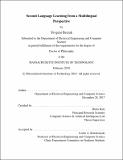| dc.contributor.advisor | Boris Katz. | en_US |
| dc.contributor.author | Berzak, Yevgeni | en_US |
| dc.contributor.other | Massachusetts Institute of Technology. Department of Electrical Engineering and Computer Science. | en_US |
| dc.date.accessioned | 2018-05-23T15:05:41Z | |
| dc.date.available | 2018-05-23T15:05:41Z | |
| dc.date.copyright | 2018 | en_US |
| dc.date.issued | 2018 | en_US |
| dc.identifier.uri | http://hdl.handle.net/1721.1/115634 | |
| dc.description | Thesis: Ph. D., Massachusetts Institute of Technology, Department of Electrical Engineering and Computer Science, 2018. | en_US |
| dc.description | This electronic version was submitted by the student author. The certified thesis is available in the Institute Archives and Special Collections. | en_US |
| dc.description | Cataloged from student-submitted PDF version of thesis. | en_US |
| dc.description | Includes bibliographical references (pages 119-127). | en_US |
| dc.description.abstract | How do people learn a second language? In this thesis, we study this question through an examination of cross-linguistic transfer: the role of a speaker's native language in the acquisition, representation, usage and processing of a second language. We present a computational framework that enables studying transfer in a unified fashion across language production and language comprehension. Our framework supports bidirectional inference between linguistic characteristics of speakers' native languages, and the way they use and process a new language. We leverage this inference ability to demonstrate the systematic nature of cross-linguistic transfer, and to uncover some of its key linguistic and cognitive manifestations. We instantiate our framework in language production by relating syntactic usage patterns and grammatical errors in English as a Second Language (ESL) to typological properties of the native language, showing its utility for automated typology learning and prediction of second language grammatical errors. We then introduce eye tracking during reading as a methodology for studying cross-linguistic transfer in second language comprehension. Using this methodology, we demonstrate that learners' native language can be predicted from their eye movement while reading free-form second language text. Further, we show that language processing during second language comprehension is intimately related to linguistic characteristics of the reader's first language. Finally, we introduce the Treebank of Learner English (TLE), the first syntactically annotated corpus of learner English. The TLE is annotated with Universal Dependencies (UD), a framework geared towards multilingual language analysis, and will support linguistic and computational research on learner language. Taken together, our results highlight the importance of multilingual approaches to the scientific study of second language acquisition, and to Natural Language Processing (NLP) applications for non-native language. | en_US |
| dc.description.statementofresponsibility | by Yevgeni Berzak. | en_US |
| dc.format.extent | 127 pages | en_US |
| dc.language.iso | eng | en_US |
| dc.publisher | Massachusetts Institute of Technology | en_US |
| dc.rights | MIT theses are protected by copyright. They may be viewed, downloaded, or printed from this source but further reproduction or distribution in any format is prohibited without written permission. | en_US |
| dc.rights.uri | http://dspace.mit.edu/handle/1721.1/7582 | en_US |
| dc.subject | Electrical Engineering and Computer Science. | en_US |
| dc.title | Second language learning from a multilingual perspective | en_US |
| dc.type | Thesis | en_US |
| dc.description.degree | Ph. D. | en_US |
| dc.contributor.department | Massachusetts Institute of Technology. Department of Electrical Engineering and Computer Science | |
| dc.identifier.oclc | 1036987447 | en_US |
